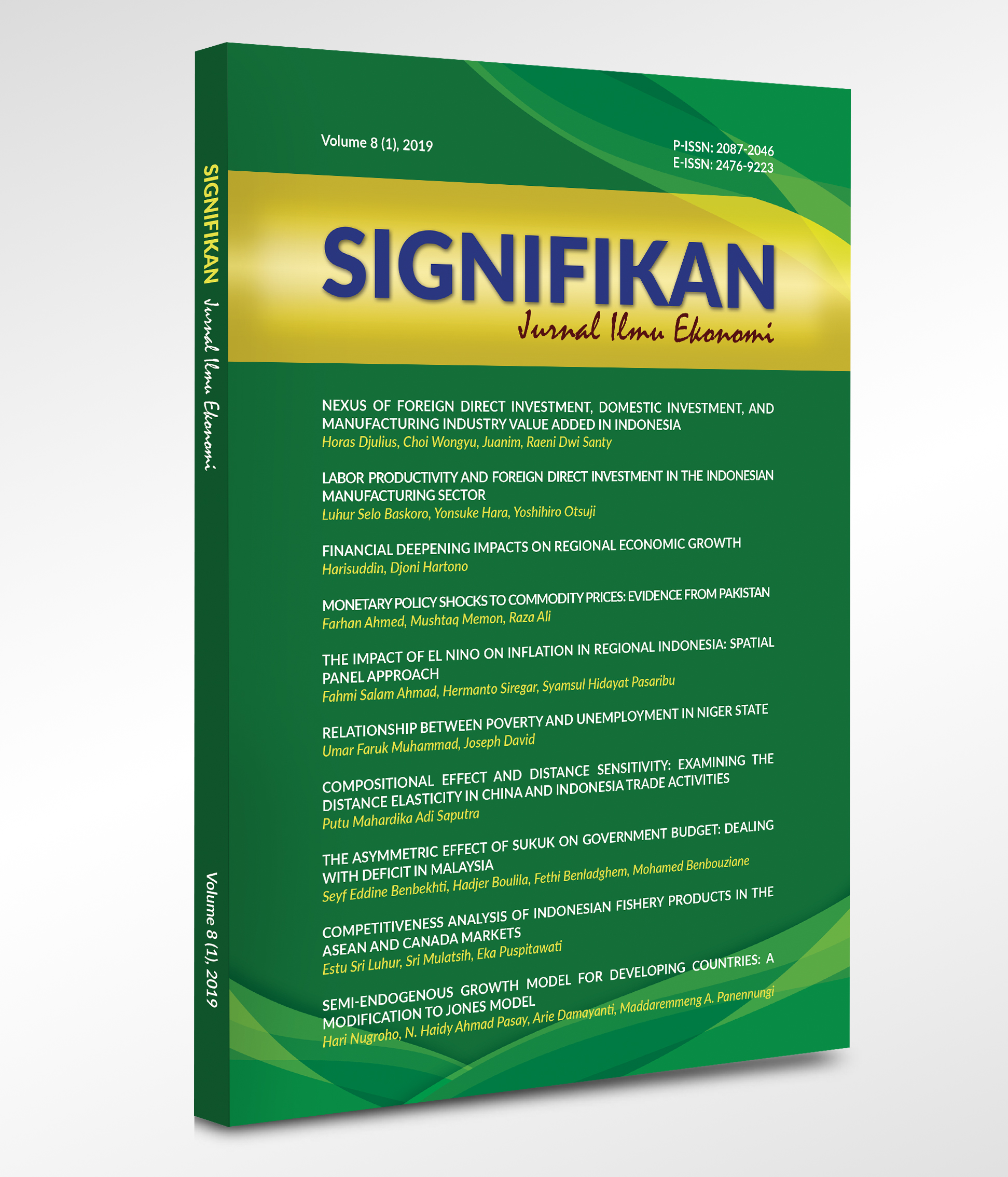Compositional Effect and Distance Sensitivity: Examining the Distance Elasticity in China and Indonesia Trade Activities
DOI:
https://doi.org/10.15408/sjie.v8i1.7469Keywords:
trade, gravity model, distance sensitivity effect, compositional effectAbstract
This paper analyzes the change in distance elasticity of trade using bilateral trade data among China and Indonesia and their main trading partners. The empirical method used in this study derived from the gravity model that considers the effect of distance on trade activities behavior. Two causes of change in the elasticity of trade to distance will be exposed, i.e., the distance sensitivity effect (within industries) and the compositional effect (among industries). Specifically, this study would like to prove whether the distance sensitivity effect is more dominant than the compositional effect in explaining the change in distance elasticity of trade. By using four sub-periods and around two hundred industries involved, the result shows that the increase in the role of distance in trade heavily caused by the escalation of distance sensitivity effect in most industries.References
Accominotti, O., & Flandreau, M. (2008). Bilateral Treaties and the Most-Favored-Nation Clause: The Myth of Trade Liberalization in the Nineteenth Century. World Politics, 60(2), 147–188.
Anderson, J. E. (1979). A Theoretical Foundation for the Gravity Equation. The American Economic Review, 69(1), 106–116.
Anderson, J. E., & van Wincoop, E. (2004). Trade Costs. Journal of Economic Literature, 42(3), 691–751.
Batra, A. (2006). India’s Global Trade Potential: The Gravity Model Approach. Global Economic Review, 35(3), 327–361.
Berthelon, M., & Freund, C. (2008). On the conservation of distance in international trade. Journal of International Economics, 75(2), 310–320.
Brun, J.-F., Carrere, C., Guillaumont, P., & de Melo, J. (2005). Has Distance Died? Evidence from a Panel Gravity Model. The World Bank Economic Review, 19(1), 99–120.
Chang, Y.-C., Polachek, S. W., & Robst, J. (2004). Conflict and trade: the relationship between geographic distance and international interactions. The Journal of Socio-Economics, 33(4), 491–509.
Coe, N. M., Kelly, P. F., & Yeung, H. W.-C. (2007). Economic Geography : A Contemporary Introduction. Malden, USA: Wiley-Blackwell.
Deardorff, A. V. (1998). Determinants of Bilateral Trade: Does Gravity Work in a Neoclassical World? In J. A. Frankel (Ed.), The Regionalization of the World Economy (p. 296). Chicago, USA: University of Chicago Press.
Dee, P., Findlay, C., & Pomfret, R. (2008). Trade Facilitation: What, Why, How, Where and When? In D. H. Brooks & J. Menon (Eds.), Infrastructure and Trade in Asia (p. 240). Northampton, USA: Edward Elgar.
Disdier, A.-C., & Head, K. (2008). The Puzzling Persistence of the Distance Effect on Bilateral Trade. Review of Economics and Statistics, 90(1), 37–48.
Eichengreen, B., & Irwin, D. A. (1995). Trade blocs, currency blocs and the reorientation of world trade in the 1930s. Journal of International Economics, 38(1–2), 1–24.
Estevadeordal, A., Frantz, B., & Taylor, A. M. (2002). The Rise and Fall of World Trade, 1870-1939. NBER Working Papers. National Bureau of Economic Research, Inc. Retrieved from https://ideas.repec.org/p/nbr/nberwo/9318.html
Frankel, J. A., Stein, E., & Wei, S.-J. (1997). Regional trading blocs in the world economic system. Washington, DC: Institute for International Economics. Retrieved from https://piie.com/bookstore/regional-trading-blocs-world-economic-system
Gil-Pareja, S., Llorca-Vivero, R., & Martínez-Serrano, J. A. (2007). The Effect of EMU on Tourism. Review of International Economics, 15(2), 302–312.
Giovannetti, G., & Sanfilippo, M. (2016). Do Chinese Exports Crowd-out African Goods? An Econometric Analysis by Country and Sector. In S. Henson & O. F. Yap (Eds.), The Power of the Chinese Dragon (pp. 10–41). London, UK: Palgrave Macmillan.
Harrigan, J. (1994). Scale Economies and the Volume of Trade. The Review of Economics and Statistics, 76(2), 321–328.
Jacks, D. S., Meissner, C. M., & Novy, D. (2010). Trade costs in the first wave of globalization. Explorations in Economic History, 47(2), 127–141.
Kunze, K. (2016). Empirical analysis of innovation and trade in Europe: a gravity model approach. International Journal of Trade and Global Markets, 9(3), 197–211.
LóPez-Córdova, J. E., & Meissner, C. M. (2003). Exchange-Rate Regimes and International Trade: Evidence from the Classical Gold Standard Era. American Economic Review, 93(1), 344–353.
Mitchener, K. J., & Weidenmier, M. (2008). Trade and Empire. The Economic Journal, 118(533), 1805–1834.
Pöyhönen, P. (1963). A Tentative Model for the Volume of Trade between Countries. Weltwirtschaftliches Archiv. Springer.
Saputra, P. M. A. (2014). The Effect of Regionalism and Infrastructure on Bilateral Trade: An Augmented Gravity Analysis for ASEAN. International Journal of Economics and Finance, 6(3), 88–95.
Tinbergen, J. (1962). Shaping the World Economy; Suggestions for an International Economic Policy. New York: Twentieth Century Fund. Retrieved from https://repub.eur.nl/pub/16826

